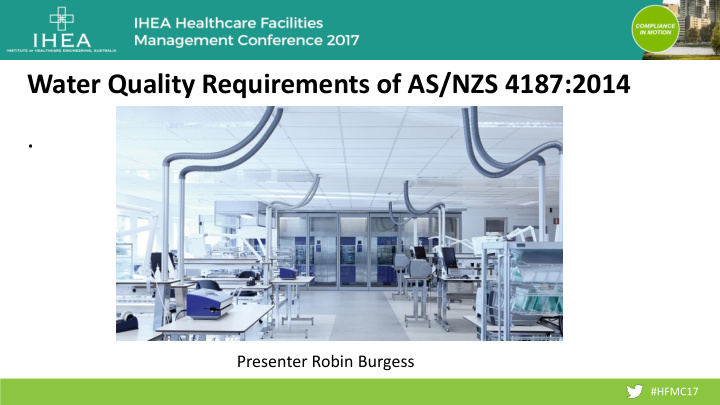



Water Quality Requirements of AS/NZS 4187:2014 . Presenter Robin Burgess #HFMC17
Table of contents • Why Water Treatment • Some Common Problems • AS/NZS 4187:2014 • Purification Methods • The Ring Main Product Water Distribution Loop • Summary #HFMC17
Why Water Treatment / Poor Quality Water Instruments • Compromised sterilisation requires higher levels of Maintenance • Shortens the life of instruments replacement costs • Repairs and replacements can be costly >10% of Inventory Cost Annually Equipment • Premature ageing of reprocessing equipment • Shortened life of reprocessing equipment Compliance – Patient Safety • AS/NZS 4187:2014 • ISO 15883 • EN 285 • GENCA
Why Water Treatment Elevated hardness: Water with residual hardness may cause white/grey staining described in the literature as “water spots”. Residual carbonate hardness may also cause a shift of pH when water is being heated and so contributes to the corrosion. Elevated / High Chloride: Chloride is the number one reason for pitting and stress corrosion. The effect depends on a number of factors such as concentration; contact time; temperature and resistance of the instrument material. Elevated / High Silicate: Silicate causes grey or coloured staining on instruments. To achieve completely stain free instruments, for example some instrument manufacturers recommend a maximum of 0.4mg/l. The effect increases dramatically in process steps where the water is allowed to dry on the instruments. pH-Value: An elevated or low pH-value may cause oxidation of the surface. The effect will depend on temperature, contact time and neutralization. Typical causes are carry over of chemistry and/or water impurities. Elevated Conductivity: Conductivity is an indicator for the sum of all free ions. Conductivity above the standard indicated impurities, but it is not always possible to determine the exact origin. #HFMC17
• Some Common Problems Copper Sulfate Fluoride Water Iron Sodium Carbonate Cu 2+ 2- SO 4 F - Calcium H 2 O Silicate Na + Fe 2+ 2- CO 3 Ca 2+ SiO 2 Zinc Phosphate Potassium Zn 2+ Bicarbonate Chloride PO 4 3- Aluminum Magnesium K + Nitrate Hydroxide - HCO 3 Cl - Al 3+ Mg 2+ - NO 3 OH - #HFMC17
• Some Common Problems Corrosive Anions Major cause of instrument damage: Biofilm , Bacteria , Spores • Sulfate, Nitrate and Phosphate can cause ― Oxidation ― Corrosion • Chlorides ― Major cause of pitting (rust spots)
• Some Common Problems Silicate • Silicates (minerals with silicon) • Found in locations where the tap water is taken from sandy locations • Tend to deposit on instruments causing opaque (at the beginning), or dark blue when layers growing thicker • In steam cause a typical “snake skin” pattern #HFMC17
• Some Common Problems • . #HFMC17
• Some Common Problems • Hard Water Elements Copper Sulfate Fluoride Water Iron Sodium Carbonate Cu 2+ 2- SO 4 F - Calcium H 2 O Silicate Na + Fe 2+ 2- CO 3 Ca 2+ SiO 2 Zinc Phosphate Potassium Zn 2+ Bicarbonate Chloride PO 4 3- Aluminum Magnesium K + Nitrate Hydroxide - HCO 3 Cl - Al 3+ Mg 2+ - NO 3 OH - #HFMC17
• Some Common Problems / Hard Water Elements Scale Build-up in Washer Disinfectors Over exposure to Acid / Silicate #HFMC17
• Some Common Problems / Metal Ions Metal Ions Plating from other less noble metal instrument Can be result from old and or damaged piping , inproper Material in RO Supply Poor Quality Supply in Lines / Building Works #HFMC17
AS/NZ4187:2014 Final Rinse Water – Washer Disinfectors (as per Section 7.2.3.1, AS/NZS 4187:2014) . 100 #HFMC17
AS/NZ4187:2014 Steam Generator Feedwater and Stream Quality – Steam Sterilizers (Table B.1 and Table B.2) . #HFMC17
• AS/NZS 4187:2014 Water Quality Testing #HFMC17
#HFMC17
• Purification Methods Water Type Characteristic Drinking water that normally Potable contains both ionic & organic impurities Softened Removal of calcium & magnesium Removal of ionic impurities, but not Deionized all organic contaminates Removal of nearly all ionic & organic Reverse Osmosis impurities #HFMC17
• Purification Methods Deionized Water Tap Water Control #HFMC17
• Purification Methods #HFMC17
• Purification Methods Installations in the past #HFMC17
• Purification Methods Installations now and in the future #HFMC17
• Purification Methods 21 #HFMC17
Purification to Distribution Loop #HFMC17
The Ring Main Product Water Distribution Loop One of the most important parts of the pure water system is the design of the ring main. We need to ensure that the system is built to ensure the consistent quality of water required. Some key considerations: • Turbulence flow by pump to retard the biofilm development • Velocity Maintenance in Return Line • Tank Turn Over – Volume Produced • Monitoring & Data logging of the process parameters • No Dead Legs #HFMC17
The Ring Main and Distribution Loop 100 Ltr 240Ltr Example product water capacity: Six 86-Series Washer-Disinfectors and Five GSS67H Sterilizer Redundancy / Failure ? If unit produced 500Ltr Hr 300Ltr Storage #HFMC17
The Ring Main Product Water Distribution Loop Getinge Australia recommend the following materials to be used for RO ring mains: • Georg Fischer Infrared welded Polypropylene Homopolymer [PPH-IR] piping • Georg Fischer Type 519 Diaphragm Valves • Georg Fischer PROGREF check valves • ESP Sanitary Sampling Ports/Valves • PNN Series Hydrophilic Nylon 0.2 Micron Membrane Filters (for advanced bacterial and endotoxin removal within circulating ring main product water). • Big Blue carbon and particle filter set on feed water line (depending on water quality) #HFMC17
• Summary Water #HFMC17
• Summary • Water for cleaning maybe of lesser quality only if contaminant levels are not significant. • If water quality is poor, then purifying method(s) should be implemented. • Water used for the final rinse of instruments and steam sterilization should be of best quality e.g. RO • For the longevity/integrity of your instruments and equipment know your water/ steam quality and test it regularly. #HFMC17
Recommend
More recommend